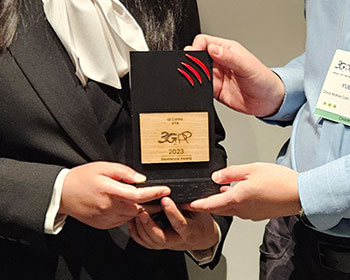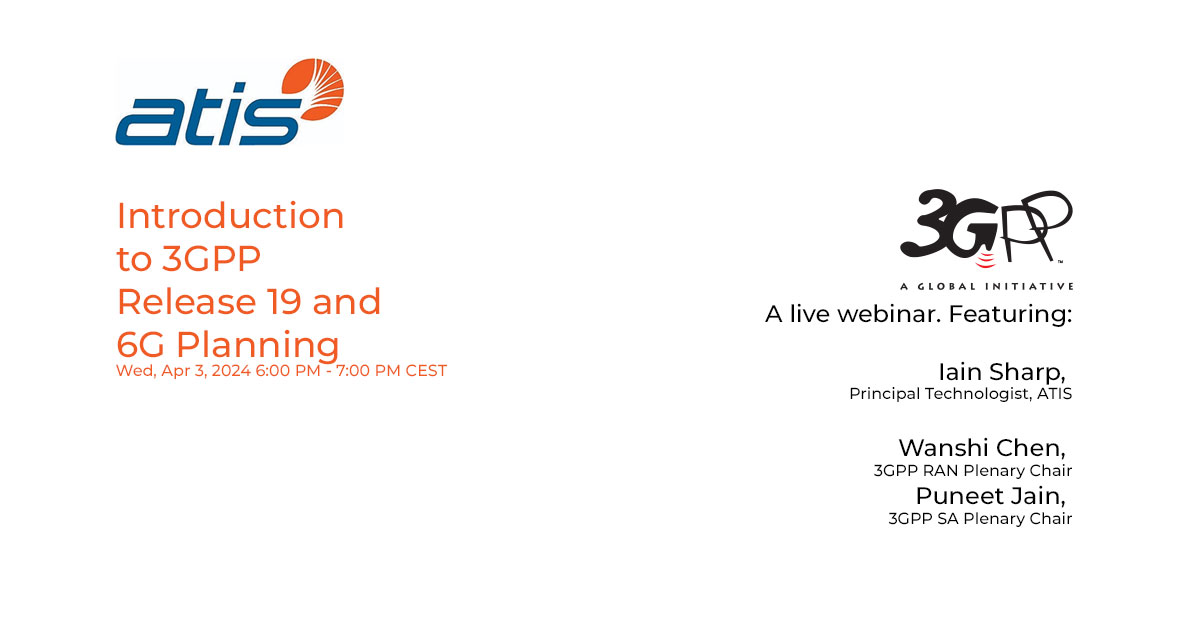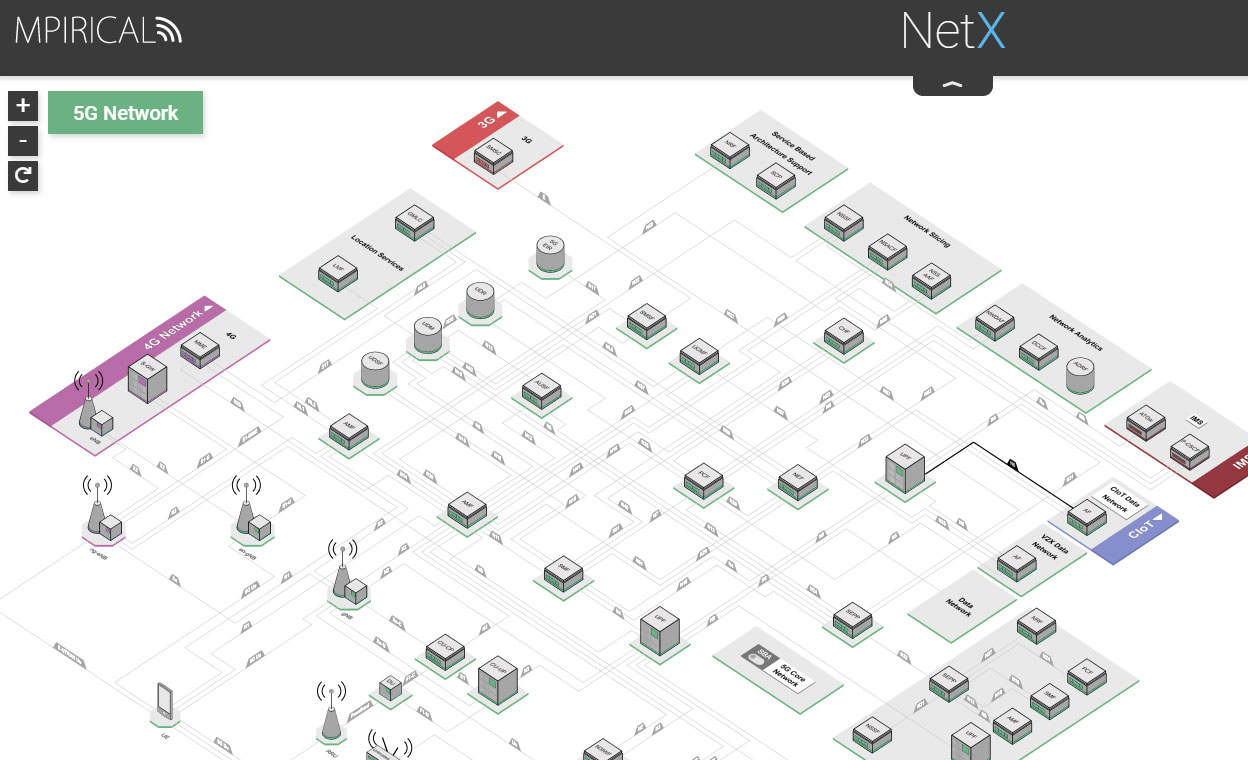Shaping the future
The 3rd Generation Partnership Project unites seven telecommunications standard development organizations, known as Organizational Partners, providing their members with a stable environment to produce the Reports and Specifications that define the 3GPP system.
-
3GPP News
-
 New 6G logo approved
New 6G logo approved
Apr 23, 2024
-
 Satellite technology of the year
Satellite technology of the year
Mar 20, 2024
-
 Awards for Excellence in 2023
Awards for Excellence in 2023
Mar 05, 2024
-
Featured News
Spotlight on...

The 3GPP Video
We have just completed and posted our new 3GPP video, on the theme of 'Why is 3GPP important to you?'
We asked experts from our RAN1 working group that question, with a view to tying in their responses to some explanatory images about what 3GPP is all about and how we make standards.

ATIS Webinar
Get the insights into 3GPP Release 19 and 6G Planning in this ATIS webinar, recorded on April 3, 2024. Video and Slide sets are now available from 3GPP founding partner ATIS.

Free access to 5G NetX
We have decided to continue providing a link to the 5G version of the NetX network map via our website.
Have a look and let us know whether it was useful to you. Any feedback will help us to ensure that this resource is relevant to the broad 3GPP community.
3GPP Global Membership
| < 20 | 20 | 40 | 60 | 80 | 100 | 120 | 140 | > 160 |
-
Australia
- CSIRO
ETSI - Dept of Home Affairs
ETSI - nbn co Limited
ETSI - Softel Systems
ETSI - Telstra Limited
ETSI
-
Austria
- BMF
ETSI - Fabasoft AG
ETSI - Frequentis AG
ETSI - Kapsch TrafficCom AG
ETSI - ORS
ETSI - Qualcomm Austria RFFE GmbH
ETSI - Tait Europe Limited
ETSI - T-Mobile Austria GmbH
ETSI
-
Belgium
- A.S.T.R.I.D. SA/NV
ETSI - Apple Benelux B.V. - Belgium
ETSI - AT&T GNS Belgium SPRL
ETSI - BIPT
ETSI - Cisco Systems Belgium
ETSI - European Commission
ETSI - EUTC
ETSI - Intel Belgium SA/NV
ETSI - InterDigital Belgium. LLC
ETSI - Nokia Belgium
ETSI - Proximus Plc
ETSI - PSCE
ETSI
-
Botswana
- BOCRA
ETSI
-
Canada
- Bell Mobility
ETSI - InterDigital Canada
ATIS - ISED
ETSI - Public Safety Canada
ETSI - RadiSys
ETSI - Rogers Communications Canada
ETSI - Sandvine Incorporated
ETSI - TELUS
ATIS - TerreStar Solutions Inc.
ATIS - VoiceAge Corporation
ETSI
-
China
- 3in
CCSA - ABP, NRTA
CCSA - ABS
CCSA - Alibaba (China) Group., Ltd.
CCSA - Apple
CCSA - Apple (Guizhou)
CCSA - Apple (Ulanqab)
CCSA - Apple Computer Trading Co. Ltd
CCSA - Apple R&D
CCSA - Apple Solutions
CCSA - Apple Trading
CCSA - AsiaInfo
CCSA - AsiaInfo Technologies Inc
ETSI - ASR
CCSA - ASTRI
ETSI - ASUSTEK COMPUTER (SHANGHAI)
CCSA - Baicells Technologies Co. Ltd
CCSA - Beijing Lenovo Software Ltd.
CCSA - BEIJING SAMSUNG TELECOM R&D
CCSA - Beijing Xiaomi Electronics
CCSA - Beijing Xiaomi Mobile Software
CCSA - Beijing Xiaomi Mobile Software
ETSI - Beijing Xiaomi Software Tech
CCSA - BIFNC
CCSA - BJTU
CCSA - BTL Inc.
ETSI - BTPDI
CCSA - BUPT
CCSA - Bytedance
CCSA - CAICT.
CCSA - CALTTA
CCSA - CATT
CCSA - CATT
ETSI - CBN
CCSA - CENC
CCSA - CEPRI
CCSA - Chengdu OPPO Telecommunication
CCSA - CHENGDU TD TECH LTD.
CCSA - China Broadnet
CCSA - China Mobile (Hangzhou) Inf.
CCSA - China Mobile (Suzhou) Software
CCSA - China Mobile Com. Corporation
CCSA - China Mobile E-Commerce Co.
CCSA - China Mobile Group Device Co.
CCSA - China Mobile International Ltd
CCSA - China Mobile M2M Company Ltd.
CCSA - China Southern Power Grid Co.
CCSA - China Telecom Corporation Ltd.
CCSA - China Telecommunications
ETSI - China Telecomunication Corp.
CCSA - China Unicom
CCSA - Chinatelecom Cloud
CCSA - Chongqing University
CCSA - CICT
CCSA - CICT
ETSI - CICT Mobile
CCSA - CICTCI
CCSA - CITC
CCSA - CMDI
CCSA - Comba
CCSA - CQUPT
CCSA - CSCN
CCSA - CTSI
CCSA - CU Digital Technology
CCSA - CUC
CCSA - CUG
CCSA - Cybercore
CCSA - Cygnusemi
CCSA - Datang Linktester Technology
CCSA - Datang Mobile Com. Equipment
CCSA - DOCOMO Beijing Labs
CCSA - Douyin
CCSA - ESSEN INNOVATION
CCSA - E-surfing Digital
CCSA - Esurfing IoT
CCSA - Fiberhome Technologies Group
CCSA - GDCNI
CCSA - GEESPACE
CCSA - GUANGDONG GENIUS TECHNOLOGY CO
CCSA - Guangdong OPPO Mobile Telecom.
CCSA - Hangzhou Douku
CCSA - Hangzhou Mengyuxiang
CCSA - HiSilicon Technologies Co. Ltd
CCSA - Honor
CCSA - Honor
ETSI - HTC Communications Co., Ltd.
CCSA - Huawei Device Co., Ltd
CCSA - HUAWEI TECHNOLOGIES Co. Ltd.
ETSI - HuaWei Technologies Co., Ltd
CCSA - Hytera Communications Corp.
CCSA - Intel China Ltd.
CCSA - IPLOOK
CCSA - iQoo
CCSA - Jetflow
CCSA - Langbo
CCSA - Lansus
CCSA - Lenovo (Beijing) Ltd
CCSA - Lenovo Future Communications
CCSA - Lenovo Information Technology
CCSA - MaxWave Micro
CCSA - MediaTek (Chengdu) Inc.
CCSA - MediaTek (Hefei) Inc.
CCSA - MediaTek (Shenzhen) Inc.
CCSA - MediaTek (Wuhan) Inc.
CCSA - MediaTek Beijing Inc.
CCSA - Meizu Technology
CCSA - Motorola Mobile Com Technology
CCSA - Nanjing Ericsson Panda Com Ltd
CCSA - Nanjing vivo Software Tech.
CCSA - Nanjing Weibo
CCSA - NERCDTV
CCSA - New H3C Technologies Co., Ltd.
CCSA - Nokia Shanghai Bell
CCSA - Nubia Technology Co.,Ltd
CCSA - NUFRONT
CCSA - OnePlus
CCSA - OPPO
ETSI - OPPO (chongqing) Intelligence
CCSA - OPPO Beijing
CCSA - Peking University
CCSA - Pengcheng laboratory
CCSA - PML
CCSA - Qihoo 360
CCSA - Quanray
CCSA - Quectel
CCSA - Ruijie Network Co. Ltd
CCSA - SAICT
CCSA - Samsung Guangzhou Mobile R&D
CCSA - Samsung Nanjing
CCSA - Samsung Shenzhen
CCSA - Sanechips
CCSA - SEU
CCSA - SGITG
CCSA - Shanghai Chen Si Electronics
CCSA - Shanghai Jiao Tong University
CCSA - Shanghai Tejet Com Technology
CCSA - Shenzhen Heytap
CCSA - ShenZhen Zhongxing Shitong
CCSA - SIA
CCSA - SmarterMicro Inc.
CCSA - Southwest Jiaotong university
CCSA - Spreadtrum Communications
CCSA - SRTC
CCSA - Starpoint
CCSA - TCL
CCSA - TD Tech Ltd
CCSA - Tencent
CCSA - Tencent Cloud
CCSA - Tongji University
CCSA - TOWE Wireless
ETSI - Transsion Holdings
CCSA - ubinexus
CCSA - UESTC
CCSA - Unicom Broadband Online
CCSA - Unicompay
CCSA - Unisoc
CCSA - Unisoc Beijing
CCSA - Vanchip
CCSA - vivo Mobile Com. (Chongqing)
CCSA - vivo Mobile Communication (H)
CCSA - vivo Mobile Communication (S)
CCSA - vivo Mobile Communication Co.,
CCSA - vivo Software Technology
CCSA - vivo Wisdom Technology
CCSA - VSENS
CCSA - Wuhan Hongxin Technology
CCSA - Xiamen Sanan Integr. Circuit
CCSA - Xiaomi Communications
CCSA - Xiaomi Digital Technology
CCSA - Xiaomi Electronic Software
CCSA - Xiaomi EV Technology
CCSA - Xiaomi Technology
CCSA - Xidian University
CCSA - Zhejiang Lab
CCSA - Zhejiang University
CCSA - ZONSON
CCSA - ZTE Corporation
CCSA - ZTE Corporation
ETSI - ZTE Photonics
CCSA - ZXNE
CCSA
-
Czech Republic
- Czech Telecommunication Office
ETSI - Mesaqin.com s.r.o (Ltd.)
ETSI - Samsung Electronics Czech
ETSI
-
Denmark
- Anemone Technology
ETSI - Apple AB Denmark
ETSI - Cobham SatCom A/S
ETSI - FORCE Technology
ETSI - Gatehouse Satcom A/S
ETSI - Nokia Denmark
ETSI - Verizon Denmark
ETSI
-
Estonia
- Jio
ETSI
-
Finland
- Bittium Wireless Ltd.
ETSI - Erillisverkot
ETSI - ETS-Lindgren Europe
ETSI - InterDigital Finland Oy
ETSI - LG Electronics Finland
ETSI - Magister Solutions Ltd
ETSI - MediaTek Finland
ETSI - Nokia Corporation
ETSI - Qualcomm Finland RFFE Oy
ETSI - TRAFICOM
ETSI - VTT
ETSI - WE Certification Oy
ETSI
-
France
- Airbus
ETSI - Apple France
ETSI - AQSACOM S.A.S.
ETSI - ATEME
ETSI - B-Com
ETSI - BOUYGUES Telecom
ETSI - CANON Research Centre France
ETSI - CEA
ETSI - Cisco Systems France
ETSI - CNES
ETSI - Cosmian
ETSI - Crosscall
ETSI - Dolby France SAS
ETSI - EDF Recherche et Développement
ETSI - EFORT
ETSI - ENENSYS
ETSI - Ericsson France S.A.S
ETSI - E-SPACE
ETSI - ETELM
ETSI - EURECOM
ETSI - Eutelsat Group
ETSI - GW
ETSI - Hewlett-Packard Enterprise
ETSI - Huawei Technologies France
ETSI - IDEMIA
ETSI - Institut Mines-Telecom
ETSI - Institute VEDECOM
ETSI - Intel Corporation SAS
ETSI - InterDigital France R&D, SAS
ETSI - Intersec
ETSI - IRT Saint Exupery
ETSI - ITRON SAS
ETSI - Kontron Transportation France
ETSI - LEGRAND FRANCE
ETSI - LG Electronics France
ETSI - Microsoft Europe SARL
ETSI - MINISTERE DE L'INTERIEUR
ETSI - Ministère Economie et Finances
ETSI - Mitsubishi Electric RCE
ETSI - Motorola Mobility France S.A.S
ETSI - MVG Industries
ETSI - Nokia France
ETSI - Orange
ETSI - PCCW Global B.V.
ETSI - Qualcomm France
ETSI - Samsung Electronics France SA
ETSI - Sequans Communications
ETSI - SGDSN
ETSI - Stellar
ETSI - TDF
ETSI - TEXAS Instruments
ETSI - THALES
ETSI - Ubiik
ETSI - Union Inter. Chemins de Fer
ETSI - ZTE FRANCE SASU
ETSI
-
Germany
- 450connect GmbH
ETSI - adare GmbH
ETSI - albis-elcon system GermanyGmbH
ETSI - Apple GmbH
ETSI - BDBOS
ETSI - BfV
ETSI - BKA
ETSI - BMWK
ETSI - BSI (DE)
ETSI - cetecom advanced GmbH
ETSI - Comprion GmbH
ETSI - Continental Automotive
ETSI - Deutsche Telekom AG
ETSI - DLR
ETSI - DOCOMO Communications Lab.
ETSI - Dolby Germany GmbH
ETSI - Ericsson GmbH, Eurolab
ETSI - European Patent Organisation
ETSI - FAU
ETSI - Fraunhofer FOKUS
ETSI - Fraunhofer HHI
ETSI - Fraunhofer IIS
ETSI - G+D MS
ETSI - Gigaset Communications GmbH
ETSI - HA/ST
ETSI - Harman GmbH
ETSI - HEAD acoustics GmbH
ETSI - HUAWEI TECH. GmbH
ETSI - IBM Europe
ETSI - INFINEON TECHNOLOGIES
ETSI - Intel Deutschland GmbH
ETSI - IPCom GmbH & Co.KG
ETSI - John Deere GmbH & Co. KG
ETSI - JSI GmbH
ETSI - Kepler
ETSI - LG Electronics Deutschland
ETSI - LKA Niedersachsen
ETSI - MediaTek Germany GmbH
ETSI - Mercedes-Benz AG
ETSI - Motorola Mobility Germany GmbH
ETSI - Motorola Solutions Germany
ETSI - Nokia Germany
ETSI - PANASONIC R&D Center Germany
ETSI - Qualcomm Germany
ETSI - ROBERT BOSCH GmbH
ETSI - ROHDE & SCHWARZ
ETSI - Samsung Electronics GmbH
ETSI - Sennheiser electronic SE
ETSI - Siemens AG
ETSI - SWR
ETSI - Tektronix GmbH
ETSI - Telefonica Germany GmbH
ETSI - Telekom Deutschland GmbH
ETSI - umlaut
ETSI - UniBw M
ETSI - UTIMACO TS GmbH
ETSI - Valeo
ETSI - VIVO TECH GmbH
ETSI - Vodafone GmbH
ETSI - Volkswagen AG
ETSI - ZITiS
ETSI - Zollkriminalamt (ZKA)
ETSI
-
Greece
- CERTH
ETSI - OTE S.A
ETSI
-
Hungary
- Ericsson Hungary Ltd
ETSI - Nokia Hungary
ETSI - SSNS
ETSI
-
India
- Astrome Technologies Pvt Lt
TSDSI - Bharti Airtel Limited
TSDSI - BSNL
TSDSI - C-DAC
TSDSI - C-DOT
TSDSI - CEWiT
TSDSI - Consort Digital
ETSI - Department of Telecom
TSDSI - ECTL
TSDSI - Elena
TSDSI - Ericsson India Private Limited
TSDSI - ERNET India
TSDSI - Huawei Telecommunication India
TSDSI - IDRBT
TSDSI - IIIT Bangalore
TSDSI - IIIT Naya Raipur
TSDSI - IISc, Bangalore
TSDSI - IIT Bhilai
TSDSI - IIT Bombay
TSDSI - IIT Delhi
TSDSI - IIT Gandhinagar
TSDSI - IIT JODHPUR
TSDSI - IIT Kanpur
TSDSI - IIT Mandi
TSDSI - IIT Patna
TSDSI - IIT, Kharagpur
TSDSI - Indian Institute of Tech (H)
TSDSI - Indian Institute of Tech (M)
TSDSI - Intel Technology India Pvt Ltd
TSDSI - ISRO
TSDSI - Ittiam System Pvt Ltd
TSDSI - Lekha Wireless Solutions
TSDSI - Marquis Technologies
TSDSI - Mediatek India Technology Pvt.
TSDSI - MeitY
TSDSI - Meta India
TSDSI - Niral
TSDSI - Nokia Solutions & Networks (I)
TSDSI - OptM Media
TSDSI - Prasar Bharati
TSDSI - Qualcomm India Pvt Ltd
TSDSI - Reliance Jio
TSDSI - Samsung R&D Institute India
TSDSI - SETS
TSDSI - Signalchip Innovations Pvt.
TSDSI - Sooktha Consulting Pvt Ltd
TSDSI - Syniverse
TSDSI - TATA Communications Ltd
TSDSI - Tata Elxsi Limited.
TSDSI - TCS
TSDSI - Tech Mahindra Limited
TSDSI - Tejas Network Limited
TSDSI - Vaan Megam
TSDSI - Wipro GE
TSDSI - Wisig Networks Pvt Ltd
TSDSI - ZTE
TSDSI
-
Ireland
- Amdocs Software Systems Ltd
ETSI - Apple Distribution Intl Ltd
ETSI - DTS Licensing Limited
ETSI - Intel Ireland
ETSI - L.M. Ericsson Limited
ETSI - Meta Ireland
ETSI - Qualcomm Technologies Ireland
ETSI - STE IDIRECT IRELAND LTD
ETSI - Vodafone Ireland Plc
ETSI - Xilinx Ireland
ETSI
-
Israel
- Allot Ltd
ETSI - Cognyte
ETSI - Elbit Systems
ETSI - Gilat
ETSI - GM - ATCI
ETSI - Softil Ltd
ETSI - Wiliot Ltd.
ETSI
-
Italy
- DP
ETSI - Ericsson Telecomunicazioni SpA
ETSI - Fastweb S.p.A.
ETSI - FBK
ETSI - Intel Corporation Italia SpA
ETSI - Leonardo SpA
ETSI - MIMIT
ETSI - QUALCOMM Europe Inc. - Italy
ETSI - TELECOM ITALIA S.p.A.
ETSI - Telit Communications S.p.A.
ETSI - UNIBO
ETSI - Vodafone Italia SpA
ETSI - ZTE Italia
ETSI
-
Japan
- Anritsu Corporation
ARIB - CNC
ETSI - DENSO CORPORATION
ARIB - DTCY
TTC - Ericsson Japan K.K.
ARIB - Facebook Japan G.K.
ARIB - Fujitsu Limited
ETSI - Fujitsu Limited.
TTC - Fujitsu Limited..
ARIB - Honda Motor Co., Ltd
ARIB - HUAWEI Technologies Japan K.K.
ARIB - Huawei Technologies Japan K.K.
TTC - ITOCHU Techno-Solutions Corp
TTC - Japan Radio Co., Ltd
ARIB - KDDI Corporation
ARIB - KDDI Corporation
TTC - Kyocera Corporation
ARIB - Kyoto University
ETSI - Mitsubishi Electric Co.
ARIB - Mitsubishi Electric Corp
TTC - Murata Manufacturing Co Ltd.
ARIB - NEC Corporation
ARIB - NEC Corporation
ETSI - NEC Corporation.
TTC - NHK
ARIB - NICT
ARIB - Nokia Japan
ARIB - NTT
TTC - NTT corporation
ETSI - NTT DOCOMO INC.
TTC - NTT DOCOMO INC..
ARIB - NTT-AT Corp.
TTC - Oki Electric Industry Co. Ltd.
TTC - Panasonic Holdings Corporation
ARIB - QUALCOMM JAPAN LLC.
ARIB - Rakuten Mobile, Inc
ARIB - SAMSUNG R&D INSTITUTE JAPAN
ARIB - SHARP Corporation
ARIB - SKY Perfect JSAT Corporation
ARIB - SoftBank Corp.
ARIB - Sony Corporation
ARIB - Sony Group Corporation
ARIB - Sumitomo Elec. Industries, Ltd
ARIB - Tomorrow's Creation Labs
ARIB - TOYOTA MOTOR CORPORATION
TTC - UTokyo
ETSI - ZTE Japan K.K.
ARIB - ZTE JAPAN K.K.
TTC
-
Korea (republic Of)
- Ajou University
TTA - DanKook University
TTA - Ericsson-LG Co., LTD
TTA - ETRI
TTA - Eurofins KCTL
ETSI - GIST
TTA - Huawei Technologies (Korea)
TTA - Hyundai Motor Company
TTA - ITL
TTA - KAIST
TTA - KIPO
TTA - Korea Testing Laboratory
TTA - Korea University
TTA - KRRI
TTA - KT Corp.
TTA - Kyonggi University
TTA - LG Electronics Inc.
TTA - LG Uplus
TTA - MediaTek Korea Inc.
TTA - MTCC
TTA - National Radio Research Agency
TTA - Nokia Korea
TTA - Qualcomm Korea
TTA - RICHTEK KOREA
TTA - Samsung Electronics Co., Ltd
TTA - SK Telecom
TTA - Soongsil University
TTA - SUNGKYUNKWAN UNIVERSITY
TTA - SyncTechno Inc.
TTA - Uangel
TTA - WILUS Inc.
TTA - ZTE Korea Limited
TTA
-
Luxembourg
- Amazon Web Services
ETSI - OQTEC
ETSI - POST Luxembourg
ETSI - SES S.A.
ETSI - Sisvel
ETSI - SnT - University of Luxembourg
ETSI
-
Mexico
- Altan Redes S.A.P.I. de C.V.
ETSI
-
Netherlands
- Apple Benelux B.V.
ETSI - ESA
ETSI - EVE Compliancy Solutions
ETSI - Group 2000
ETSI - KPN N.V.
ETSI - MinEA
ETSI - NCI Agency
ETSI - Netherlands Police
ETSI - NXP Semiconductors Netherlands
ETSI - Odido
ETSI - one2many B.V.
ETSI - Philips International B.V.
ETSI - PIDS
ETSI - Qualcomm Tech. Netherlands B.V
ETSI - Reflection B.V.
ETSI - SpaceX
ETSI - TNO
ETSI
-
New Zealand
- Spark NZ Ltd
ATIS
-
Norway
- Ceragon Networks AS
ETSI - NCIS
ETSI - Nkom
ETSI - Nordic Semiconductor ASA
ETSI - TELENOR ASA
ETSI
-
Poland
- Intel Technology Poland SP Zoo
ETSI - LG Electronics Polska
ETSI - Nokia Poland
ETSI - Samsung Electronics Polska
ETSI - T-Mobile Polska S.A.
ETSI
-
Portugal
- PT PORTUGAL SGPS SA
ETSI
-
Romania
- Orange Romania
ETSI - Vodafone Romania S.A.
ETSI
-
Serbia
- RATEL
ETSI
-
Singapore
- CSA
ETSI - IMDA
ETSI - SUTD
ETSI
-
Slovakia
- Ministry of Transport SR
ETSI
-
Slovenia
- SIST
ETSI
-
Spain
- Cellnex
ETSI - CTTC
ETSI - DAC-SSR-UPC
ETSI - DARS TELECOM S.L.
ETSI - DEKRA
ETSI - EMITE
ETSI - Ericsson España S.A.
ETSI - HISPASAT SA
ETSI - MINECO
ETSI - Motorola Mobility España SA
ETSI - NEMERGENT
ETSI - Orange Spain
ETSI - QUALCOMM Europe Inc. - Spain
ETSI - Samsung Electronics Iberia SA
ETSI - Sateliot
ETSI - TELEFONICA S.A.
ETSI - UMA
ETSI - UPV/EHU
ETSI - VALID SOLUCIONES TECNOLÓGICAS
ETSI - Verizon Spain
ETSI
-
Sweden
- Arriver Software AB
ETSI - BeammWave AB
ETSI - Bluetest AB
ETSI - DIGG
ETSI - Dolby Sweden AB
ETSI - Ericsson LM
ETSI - Huawei Technologies Sweden AB
ETSI - Husqvarna AB
ETSI - Intel Sweden AB
ETSI - MediaTek Sweden AB
ETSI - NDRE
ETSI - Polisen
ETSI - PTS
ETSI - RISE
ETSI - Samsung Electronics Nordic AB
ETSI - Sectra Communications AB
ETSI - Security Service
ETSI - Telia Company AB
ETSI - Trafikverket
ETSI - Verizon Sweden
ETSI
-
Switzerland
- Apple Switzerland AG
ETSI - EBU
ETSI - Embotech AG
ETSI - Ofcom (CH)
ETSI - Schindler
ETSI - Semtech Neuchatel SA
ETSI - STMicroelectronics
ETSI - SWISSCOM
ETSI - u-blox AG
ETSI - Verizon Switzerland AG
ETSI
-
Taiwan, Province Of China
- Acer Incorporated
ETSI - Bureau Veritas ADT
ETSI - CCU
ETSI - CHTTL
ETSI - III
ETSI - ISSDU
ETSI - ITRI
ETSI - MediaTek Inc.
ETSI - NTPU
ETSI - NTU
ETSI - NYCU
ETSI - Sporton International Inc
ETSI - Tron Future Tech Inc.
ETSI
-
Türkiye
- ASELSAN
ETSI - IMU
ETSI - P.I. WORKS
ETSI - Plan-S
ETSI - Turk Telekomunikasyon A.S.
ETSI - TURKCELL
ETSI - Vestel
ETSI - Vodafone Telekomünikasyon A.S.
ETSI
-
Uganda
- CGL
ETSI
-
United Arab Emirates
- THURAYA TELECOM CO.
ETSI - TII
ETSI
-
United Kingdom
- AccelerComm Ltd
ETSI - Anritsu EMEA Ltd
ETSI - Apple (UK) Limited
ETSI - ARTICLE19
ETSI - Avanti
ETSI - BAE Systems AI Ltd
ETSI - BBC
ETSI - Broadcom (EU)
ETSI - BT plc
ETSI - Cambium Networks Limited
ETSI - CAMBRIDGE CONSULTANTS LTD
ETSI - Catapult
ETSI - CKH IOD UK LIMITED
ETSI - cstconsultancy
ETSI - DSIT
ETSI - EA Consult Services Ltd
ETSI - EchoStar
ETSI - Element Materials Technology
ETSI - Ericsson Limited
ETSI - Etherstack Wireless Limited
ETSI - HOME OFFICE
ETSI - Huawei Tech.(UK) Co.. Ltd
ETSI - Huawei Technologies R&D UK
ETSI - ICS
ETSI - Inmarsat
ETSI - Intel Corporation (UK) Ltd
ETSI - InterDigital, Europe, Ltd.
ETSI - Intertek
ETSI - Keysight Technologies UK Ltd
ETSI - LG Electronics UK
ETSI - Maketh Secure Limited
ETSI - MediaTek UK
ETSI - Motorola Mobility UK Ltd.
ETSI - Motorola Solutions UK Ltd.
ETSI - National Technical Assistance
ETSI - NCSC
ETSI - NEC Europe Ltd
ETSI - NEC Telecom MODUS Ltd.
ETSI - Network Rail
ETSI - Nokia UK
ETSI - NOVAMINT
ETSI - Ofcom (U.K.)
ETSI - Orange UK
ETSI - Qualcomm Technologies Int
ETSI - Samsung R&D Institute UK
ETSI - Sensus UK
ETSI - Sepura Ltd
ETSI - SGS Wireless
ETSI - Smart Internet Lab
ETSI - Sony Europe B.V.
ETSI - Telesat International Limited
ETSI - Toshiba
ETSI - TTP plc
ETSI - UL VS Ltd
ETSI - Verizon UK Ltd
ETSI - ViaSat Satellite Holdings Ltd
ETSI - VIAVI Solutions
ETSI - VODAFONE Group Plc
ETSI
-
United States
- Analog Devices, Inc.
ATIS - Anterix
ATIS - Apple Inc
ATIS - AT&T
ATIS - AT&T Labs, Inc
ATIS - AT&T Services, Inc.
ATIS - C Spire Wireless
ATIS - CableLabs
ETSI - Cadence Design Systems Inc.
ETSI - Casa Systems Inc.
ETSI - Charter Communications, Inc
ATIS - CIS
ETSI - CISA ECD
ATIS - Cisco Systems
ATIS - Cohere Technologies
ATIS - Collins Aerospace
ATIS - Comcast
ATIS - Comtech Telecommunications Cor
ATIS - Convida Wireless
ETSI - Dell Technologies
ATIS - DISA
ATIS - Dish Network
ATIS - Ericsson Inc.
ATIS - Everactive
ATIS - F5
ETSI - FCC
ATIS - FirstNet
ATIS - Ford
ETSI - Futurewei
ETSI - Futurewei Technologies
ATIS - GE Network Technologies, LLC
ATIS - GLOBALSTAR Inc.
ETSI - Google Inc.
ATIS - GTRC
ETSI - Intel
ATIS - Intelsat
ATIS - InterDigital Communications
ATIS - InterDigital New York
ATIS - InterDigital Pennsylvania
ATIS - InterDigital, Inc.
ETSI - Iridium Satellite LLC
ATIS - JMA Wireless
ATIS - Johns Hopkins University APL
ATIS - Juniper Networks
ETSI - Kymeta Corporation
ETSI - L3Harris Technologies
ATIS - Ligado Networks
ETSI - Lockheed Martin
ATIS - Lynk Global
ATIS - MATRIXX Software
ETSI - Mavenir
ETSI - Meta USA
ATIS - Microchip Technology, Inc.
ATIS - MidWave Wireless
ATIS - MITRE Corporation
ETSI - National Instruments Corp.
ETSI - National Spectrum Consortium
ATIS - Netscout Systems Inc.
ETSI - NextNav
ATIS - NIST
ATIS - Nokia
ATIS - NTIA
ATIS - NVIDIA
ATIS - Omnispace
ATIS - ONE Media 3.0 LLC
ATIS - Oracle Corporation
ETSI - OTD_US
ATIS - Peraton Labs
ATIS - PHY Wireless
ATIS - Polaris Wireless
ATIS - Qorvo
ETSI - Qualcomm Incorporated
ATIS - Samsung Research America
ATIS - SDI Squared
ETSI - Skylo Technologies
ATIS - Skyworks Solutions Inc.
ETSI - Southern Linc.
ATIS - Spirent Communications
ETSI - SS8
ETSI - Swift Navigation
ATIS - TA
ETSI - Teradyne
ATIS - Texas A&M University
ETSI - Tiami Networks
ATIS - T-Mobile USA
ETSI - T-Mobile USA Inc.
ATIS - TOYOTA Info Technology Center
ETSI - TransUnion
ATIS - Trimble
ATIS - U.S. Department of Defense
ATIS - U.S. Department of Transport.
ATIS - U.S. National Security Agency
ATIS - Union Telephone Company
ATIS - US Cellular Corporation.
ATIS - US DHS Science & Technology
ATIS - Valid8
ETSI
0
Countries0
Organizational Partner Members0
Number delegates at meetings this year0
3GPP Meetings per year0
3GPP Specifications0
3GPP 'Change Requests' to date






